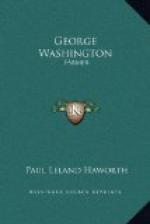In addition to these lands in the settled parts of Virginia he also had claims to vast tracts in the unsettled West. For services in the French and Indian War he was given twenty thousand acres of wild land beyond the mountains—a cheap mode of reward, for the Ohio region was to all intents and purposes more remote than Yukon is to-day. Many of his fellow soldiers held their grants so lightly that he was able to buy their claims for almost a song. The feeling that such grants were comparatively worthless was increased by the fact that to become effective they must be located and surveyed, while doubt existed as to whether they would be respected owing to conflicting claims, jurisdictions and proclamations.
[Illustration: The Porter’s Lodge]
[Illustration: Driveway from the Lodge Gate]
Washington, however, had seen the land and knew it was good and he had prophetic faith in the future of the West. He employed his old comrade Captain William Crawford to locate and survey likely tracts not only in what is now West Virginia and western Pennsylvania, but beyond the Ohio River. Settlement in the latter region had been forbidden by the King’s proclamation of 1763, but Washington thought that this was merely a temporary measure designed to quiet the Indians and was anxious to have picked out in advance “some of the most valuable land in the King’s part.” In other words he desired Crawford to act the part of a “Sooner,” in the language of more than a century later.
In this period a number of companies were scrambling for western lands, and Washington, at one time or another, had an interest in what was known as the Walpole Grant, the Mississippi Company, the Military Company of Adventurers and the Dismal Swamp Company. This last company, however, was interested in redeeming lands about Dismal Swamp in eastern Virginia and it was the only one that succeeded. In 1799 he estimated the value of his share in that company at twenty thousand dollars.
Washington took the lead in securing the rights of his old soldiers in the French War, advancing money to pay expenses in behalf of the common cause and using his influence in the proper quarters. In August, 1770, he met many of his former officers at Captain Weedon’s in Fredericksburg, and after they had dined and had talked over old times, they discussed the subject of their claims until sunset, and it was decided that Washington should personally make a long and dangerous trip to the western region.
In October he set out with his old friend Doctor James Craik and three servants, including the ubiquitous Billy Lee, and on the way increased the party. They followed the old Braddock Road to Pittsburgh, then a village of about twenty log cabins, visiting en route some tracts of land that Crawford had selected. At Pittsburgh they obtained a large dugout, and with Crawford, two Indians and several borderers, floated down the Ohio, picking out and marking rich bottom lands and having great sport hunting and fishing.




